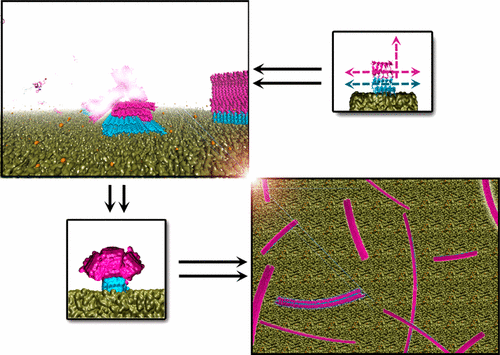ABSTRACT:Amyloid-β (Aβ) and human islet polypeptide (hIAPP) are the causative agents responsible for Alzheimer’s disease (AD) and type II diabetes (T2D), respectively. While numerous studies have reported the cross-seeding behavior of Aβ and hIAPP in solution, little effort has been made to examine the cross-seeding of Aβ and hIAPP in the presence of cell membranes, which is more biologically relevant to the pathological link between AD and T2D. In this work, we computationally study the cross-seeding and adsorption behaviors of Aβ and hIAPP on zwitterionic POPC and anionic 1-palmitoyl-2-oleoyl-sn-glycero-3-phosphocholine (POPC)/1-palmitoyl-2-oleoyl-sn-glycero-3-phosphatidylglycerol (POPG) mixed bilayers using all-atom molecular dynamics (MD) simulations, particularly aiming to the effects of the initial orientation of the Aβ-hIAPP assembly and the lipid composition of cell membranes on mutual structural and interaction changes in both Aβ-hIAPP assembly and lipid bilayers at the atomic level. Aβ-hIAPP cross-seeding assembly always preferred to adopt a specific orientation and interface to associate with both lipid bilayers strongly via the N-terminal strands of Aβ. Such membrane-bound orientation explains experimental observation that hybrid Aβ-hIAPP fibrils on cell membranes showed similar morphologies to pure hIAPP fibrils. Moreover, Aβ-hIAPP assembly, regardless of its initial orientations, interacted more strongly with POPC/POPG bilayer than POPC bilayer, indicating that electrostatic interactions are the major forces governing peptide-lipid interactions. Strong electrostatic interactions were also attributed to the formation of Ca2+ bridges connecting both negatively charged Glu of Aβ and PO4 head groups of lipids, which facilitate the association of Aβ-hIAPP with the POPC/POPG bilayer. It was also found that the strong peptide–lipid binding reduced lipid fluidity. Both facts imply that Aβ-hIAPP assembly may induce cell damage by altering calcium homeostasis and cell membrane phase. This work provides a better fundamental understanding of cross-seeding of Aβ and hIAPP on cell membranes and a potential pathological link between AD and T2D.
